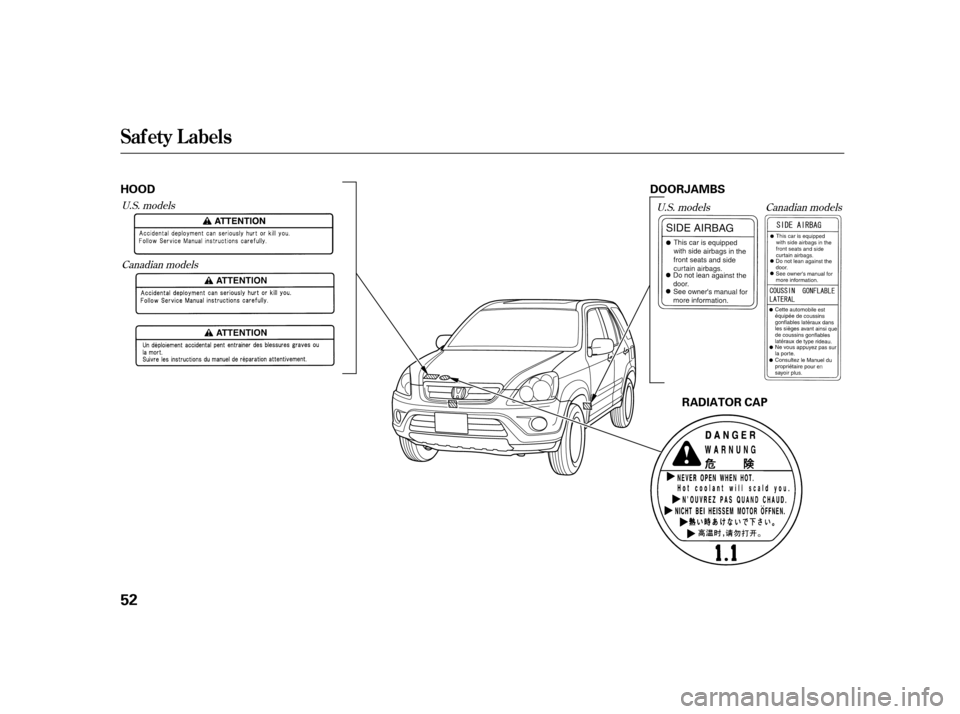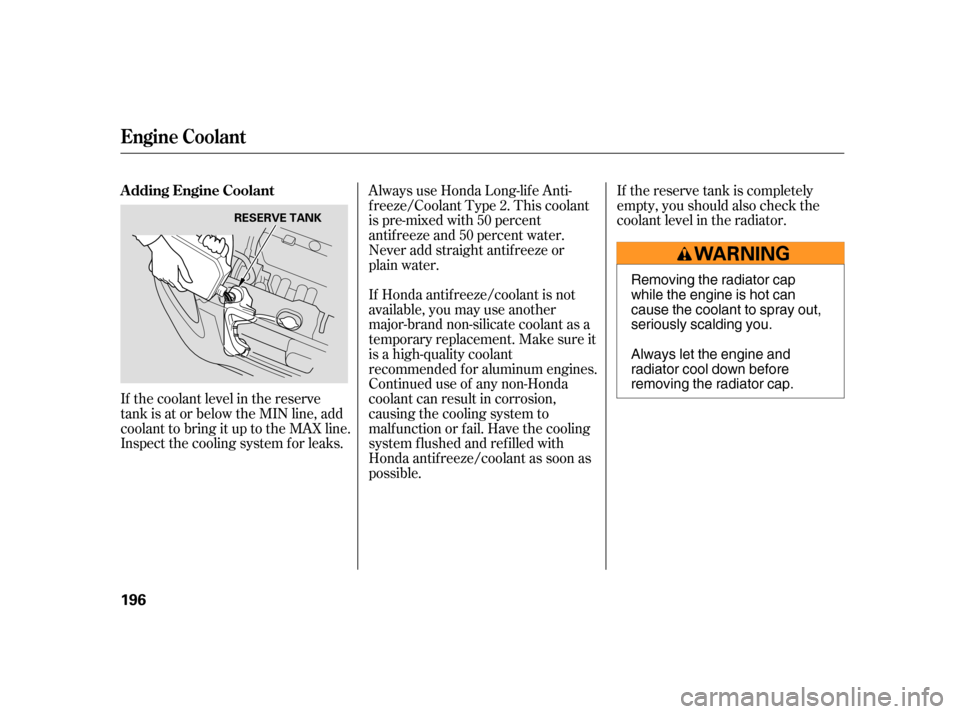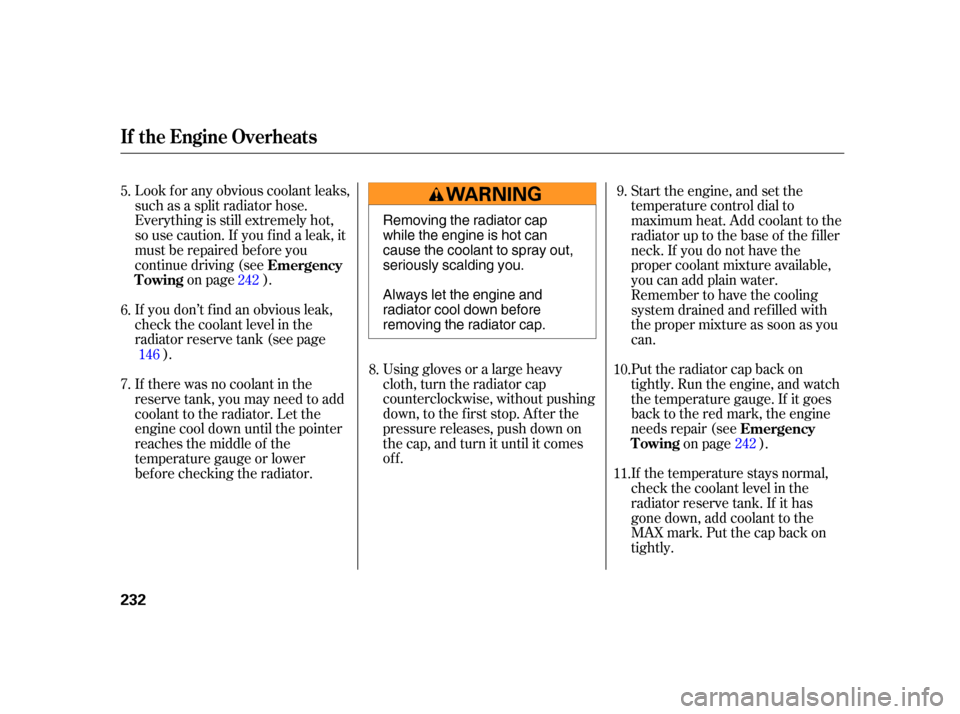radiator cap HONDA CR-V 2005 RD4-RD7 / 2.G Owners Manual
[x] Cancel search | Manufacturer: HONDA, Model Year: 2005, Model line: CR-V, Model: HONDA CR-V 2005 RD4-RD7 / 2.GPages: 274, PDF Size: 4.34 MB
Page 55 of 274

Canadian modelsU.S. models U.S. models
Canadian models
Saf ety L abels
52
HOOD
RADIATOR CAP
DOORJAMBS
Page 195 of 274

Fluid Locations
192
ENGINE OIL FILL CAP
POWER STEERING FLUID(Red cap)
ENGINE COOLANTRESERVOIR
RADIATOR CAP
WASHER FLUID (Blue cap)
AUTOMATIC TRANSMISSIONFLUID DIPSTICK(Yellow loop)
ENGINE OIL DIPSTICK(Orange handle)
BRAKE FLUID (Black cap)
CLUTCH FLUID (ManualTransmission only)(Gray cap)
Page 199 of 274

If Honda antif reeze/coolant is not
available, you may use another
major-brand non-silicate coolant as a
temporaryreplacement.Makesureit
is a high-quality coolant
recommended f or aluminum engines.
Continued use of any non-Honda
coolant can result in corrosion,
causing the cooling system to
malf unction or f ail. Have the cooling
system f lushed and ref illed with
Honda antif reeze/coolant as soon as
possible.
If the reserve tank is completely
empty, you should also check the
coolant level in the radiator.
If the coolant level in the reserve
tank is at or below the MIN line, add
coolant to bring it up to the MAX line.
Inspect the cooling system f or leaks.
Always use Honda Long-lif e Anti-
f reeze/Coolant Type 2. This coolant
is pre-mixed with 50 percent
antif reeze and 50 percent water.
Never add straight antifreeze or
plain water.
Engine Coolant
A dding Engine Coolant
196
RESERVE TANK
Removing the radiator cap
while the engine is hot can
cause the coolant to spray out,
seriously scalding you.
Always let the engine and
radiator cool down before
removing the radiator cap.
Page 200 of 274

When the radiator and engine are
cool, relieve any pressure in the
cooling system by turning the
radiator cap counterclockwise,
without pressing down.
The coolant level should be up to
the base of the f iller neck. Add
coolant if it is low.
Pourthecoolantslowlyand
caref ully so you do not spill any.
Clean up any spill immediately; it
could damage components in the
engine compartment.
Put the radiator cap back on and
tighten it.
Do not add any rust inhibitors or
other additives to your vehicle’s
cooling system. They may not be
compatible with the coolant or
engine components.
Remove the radiator cap by
pushingitdownandturningit
counterclockwise.
Pour coolant into the reserve tank.
Fill it half way between the MAX
and MIN marks. Put the cap back
on the reserve tank.
3.
4.
5.
2.
1.
Engine Coolant
Maint enance
197
RADIATOR CAP RESERVE TANK
Page 235 of 274

Look f or any obvious coolant leaks,
such as a split radiator hose.
Everything is still extremely hot,
so use caution. If you f ind a leak, it
must be repaired bef ore you
continue driving (seeon page ).
If you don’t f ind an obvious leak,
check the coolant level in the
radiator reserve tank (see page ). Using gloves or a large heavy
cloth, turn the radiator cap
counterclockwise, without pushing
down, to the f irst stop. Af ter the
pressure releases, push down on
the cap, and turn it until it comes
off. Put the radiator cap back on
tightly. Run the engine, and watch
the temperature gauge. If it goes
back to the red mark, the engine
needs repair (see
on page ).
If the temperature stays normal,
check the coolant level in the
radiator reserve tank. If it has
gone down, add coolant to the
MAX mark. Put the cap back on
tightly.
If there was no coolant in the
reserve tank, you may need to add
coolant to the radiator. Let the
engine cool down until the pointer
reaches the middle of the
temperature gauge or lower
bef ore checking the radiator. Start the engine, and set the
temperature control dial to
maximum heat. Add coolant to the
radiator up to the base of the f iller
neck. If you do not have the
proper coolant mixture available,
you can add plain water.
Remember to have the cooling
system drained and ref illed with
the proper mixture as soon as you
can.
9.
8.
7. 6. 5.
11. 10.
242
146
242
Emergency
Towing
Emergency
Towing
If theEngineOverheats
232
Removing the radiator cap
while the engine is hot can
cause the coolant to spray out,
seriously scalding you.
Always let the engine and
radiator cool down before
removing the radiator cap.